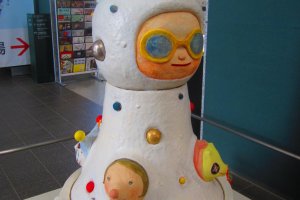The City of Kasama has a history of pottery-making going back over 1500 years, with ancient kilns still being unearthed from the local hills. To this day there are regional artists working with both traditional and innovative methods to produce several hundred tons of ceramic pieces per year, and you can’t throw a plate in Kasama without hitting a tiny gallery or workshop. So, it seems exceptionally fitting that this historic location be the setting and site for the Ibaraki Ceramic Art Museum.
Originally built 13 years ago with funding and land provided by the prefecture of Ibaraki, the museum is an interestingly designed concrete building sitting proudly atop one of Kasama’s many tall hills, surrounded by lush woods and fertile lawns. It not only offers exhibitions on three separate levels, it also has a lovely gift shop right near the front door and a small Japanese eatery where you can dine on locally produced ceramic tableware.
Keeping with its rather young age, the building itself is decorated with scattered modern art installations, including the adorably (and deceivingly) named ‘Fluffy 5’, which comprises of five cloud-bubble shaped aluminum pieces in five different colors arranged on the lawn beside a viewing window. The exhibitions themselves usually veer towards the modern and contemporary arm of the art world, often comprised of pieces that would not normally fall into the assumed category of ‘ceramics’. A teacup poodle, inside a teacup, painted in a Wedgewood style motif. A leather jacket and handbag that look so authentic it’s hard to believe they weigh several dozen kilos. Pieces are so delicate and detailed it seems the artists themselves must have cast them fully formed from their imaginations. And each one has a separate story and thought-process that intrigues and beguiles the viewer; an attempt to expose the way things change through the process of time and heat, attempts to subvert our preconceptions about objects, explorations of the limits of the medium and craft.
Overall, the museum works in a symbiotic fashion with the local artists and community, providing the artists a location to showcase their wares and expand their audiences, and giving locals and visitors alike a glimpse at the innovative and intriguing new worlds of ceramic art that are constantly being formed within the region. Most of the up-and-coming artists of the region are young females, and their fascinatingly nuanced work features prominently in many of the exhibits.
Their usual collection consists of some of the most famous and renowned ceramic artists from around the country, featuring some breath-taking pieces of skillful construction. Of particular note is Matsui Kosei, whose work often involved layering different colors of clay, making patterns, and then expanding the clay on a wheel to create a double-layer double-colored pattern. Another artist, Itaya Hazan, is known for his beautiful celadon-style glazes and delicate carving of pieces; his etchings are so well done that they appear as embossing as opposed to being sunken into the piece as you would expect.
However, for those who prefer a more natural encounter with art, the woods surrounding the museum are filled with whimsical pieces, especially the ‘Clay Forest of the Magician’. As you climb the slight hills there are colorful mosaics, rows of clay birds, and even a giant dog collar for the woods’ ‘canine guardian’ (big enough to hold an elephant!). Across the street from the museum is a large gift shop filled with particularly expensive pieces and local foods, complete with a small cake shop and café that also serves soft ice cream. As a result, it is easy to make a day of it here; a tour of the museum and its fascinating pieces, a walk in the whimsical woods, some snacks and shopping to round off the day. For a glimpse at Kasama’s past and future, the Ibaraki Ceramic Art Museum is a highly attractive choice.


































